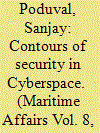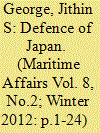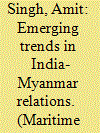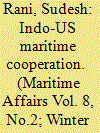|
|
|
Sort Order |
|
|
|
Items / Page
|
|
|
|
|
|
|
| Srl | Item |
| 1 |
ID:
117149


|
|
|
|
|
| Publication |
2012.
|
| Summary/Abstract |
In broad pursuance of the goals of China's national defence in the new era, the People's Liberation Army Navy has been mainly tasked with the defence of its maritime rights, interests and security, safeguarding its economic development and serving its peaceful diplomacy. The Chinese submarines figure prominently in their military strategy of "Active Defence." The blistering pace of submarine modernisation, supporting infrastructure and intensive training regimen bear testimony to their centrality in the Chinese 'Offshore Defence' maritime thought process. With their nuclear attack submarines particularly capable of far-ranging missions of long durations, the United States as the predominantly present maritime power in the western and central Pacific Ocean will invariably stand to be affected. A real possibility of their deployment into the Indian Ocean in the medium to long term will also impact on the Indian maritime security scenario. Hence, it is prudent to carefully assess the Chinese nuclear submarine program.
|
|
|
|
|
|
|
|
|
|
|
|
|
|
|
|
| 2 |
ID:
117148


|
|
|
|
|
| Publication |
2012.
|
| Summary/Abstract |
The cyberspace is an intangible medium operating and controlling many aspects of the tangible world. It is a world without barriers therefore artificial barriers have to be erected to prevent free ingress or egress. This is a world still in the nascent stages of its evolution; therefore to stay ahead of the pack we need to be imaginative and innovative. The increasing interconnection of the world's computers, standardization of communications protocols and computing hardware enable a single worm developed attack many systems. This provides attractive avenues for cyber attackers to exploit. Complementing these features, are today's cyber criminals who are increasingly adept at gaining undetected access and maintaining a persistent, low-profile, long-term presence in IT environments. Moreover difficulties in identifying attackers, coupled with an uncertain legal and policy framework, make it difficult to punish the offenders. Therefore, one has to take proactive steps, be vigilant and increase the cost of intrusions to keep unwanted visitors at bay. Today cyber attackers, armed with constantly evolving malicious code are likely to have more paths into a network and extract the secrets it contains making the task of the system administrators a herculean one. The elegance of computer hacking lies in the fact that it may be attempted for a fraction of the cost; all one requires is a laptop connected to the internet and a lot of patience. With this in mind the paper attempts to give an insight into the various contours of cyber security which should be a valuable tool in appreciating the vulnerabilities of the cyberspace.
|
|
|
|
|
|
|
|
|
|
|
|
|
|
|
|
| 3 |
ID:
117145


|
|
|
|
|
| Publication |
2012.
|
| Summary/Abstract |
Security and defence issues in Japan are still considered to be a topic which induces debate and controversies. Defence forces and actors are submerged under myriad layers of civilian control; as a result the voice of military is often muzzled. Since the 1990s, the levers of control are shifting, muted military expressions are becoming clear, and the civilian administration too understands the need for a realistic outlook on security matters. This change does not insinuate that Japan is going back to remilitarisation way of the 1930s. Bequeathed with robust democratic structures since World War II, Japanese defence decision-making follows a certain pattern and trend. Many studies in English have examined Japan's economic, trade, and security policies, while Japan's defence decision-making has not been analysed. In recognising this neglect, this study focuses on the defence decision-making process from the decision-makers points of view. This study will aim to clear some doubts over the Japanese decision-making process opaqueness.
|
|
|
|
|
|
|
|
|
|
|
|
|
|
|
|
| 4 |
ID:
117146


|
|
|
|
|
| Publication |
2012.
|
| Summary/Abstract |
Myanmar is an important neighbour of India as it shares extensive land borders with India's north-eastern states and maritime borders in the Bay of Bengal. The long spell of Myanmar's military rule forced India to follow a policy of disengagement with the Burmese authorities. It was only after India initiated its "Look East" policy in the 1990s New Delhi started its engagement with the military junta. Moreover, the recent democratisation of Myanmar has the potential to take India-Myanmar relations to a new height.
|
|
|
|
|
|
|
|
|
|
|
|
|
|
|
|
| 5 |
ID:
117147


|
|
|
|
|
| Publication |
2012.
|
| Summary/Abstract |
January 26, 2013; Somewhere off the Sir Creek: An important naval operation is called for during the early morning hours to support a team of the Army's elite Special Forces (SF) deployed inland as part of a force committed to breaking up a concentration of terrorists with ties to an international organisation. The weather forecast predicts clear skies. As the operation commences just after sunrise heavy fog descends on the sea coast. The SF team moves in as per the previously decided H-hour expecting fire support from sea. The laser designator to direct the missile from the ship fails to acquire the target. The fire support however, continues without accurate spotting due to reduced visibility. Radio communications between the SF team and the naval ship become unreliable. By the time news of the SF advance and their new positions are relayed to the naval commander, the SF team has taken significant casualties. Some terrorists escape although the operation is declared a success. However, the conduct of such joint operations in the future is now endangered. Subsequent analysis released by the navy's meteorological department suggests that an early morning temperature inversion was the cause of the fog build-up and the strong atmospheric gradient resulted in poor radio communications.
August 15, 2013; Somewhere off the Coast of Andaman and Nicobar Islands: A ship suspected of carrying contraband arms has been tracked and is heading for the harbour of a hostile naval base. A Marine Commando team is to be dispatched by a high-speed boat to intercept, board, and take control of the vessel. The team leader checks with the Met officer and ascertains that the wave heights are averaging 3 feet from the southeast. He estimates the intercept can be made a few miles before the ship enters hostile waters if the boat averages 10 knots. The moment the mission is launched at 2300 hours, a tornado develops and the wave height reaches 6 feet. As the boat picks up speed, the violent shocks of the craft engaging the 6-foot seas directly on the bow become unbearable to the team and the boat crew. The boat had to slow to 5 knots and finally the intercept is missed.
|
|
|
|
|
|
|
|
|
|
|
|
|
|
|
|
| 6 |
ID:
117150


|
|
|
|
|
| Publication |
2012.
|
| Summary/Abstract |
In 1991, after the denouement of the Soviet Union and the end of the bipolar world, major changes took place at the international level. In the wake of these changes, India and the US had to re-adjust their policies and relations that led to cordial India-US relations. Maritime relations were not immune to these winds of change. In the maritime domain, India has adopted a different attitude towards the US presence in the Indian Ocean as compared to the Cold War period. The United States has also recognized India as a major security provider in the Indian Ocean Region (IOR) as the Indian Navy is the largest force in the region. Through the maritime cooperation, both nations can provide the secure and stable environment in the IOR, which is the stated aim of both the countries. In this regard, this paper tries to analyse India-US maritime relations during the Cold War era as well as the post-Cold War period.
|
|
|
|
|
|
|
|
|
|
|
|
|
|
|
|
|
|
|
|
|